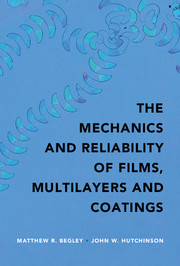Book contents
- Frontmatter
- Contents
- Acknowledgements
- Notation
- 1 Introduction
- 2 Key Mechanics Concepts
- 3 Linear Elastic Fracture Mechanics
- 4 Steady-State Delamination of Bilayers
- 5 Steady-State Delamination in Multilayers
- 6 Steady-State Channeling and Tunneling Cracks
- 7 Crack Kinking from an Interface
- 8 Crack Penetration, Deflection or Arrest?
- 9 Edge and Corner Interface Cracks
- 10 Buckling Delamination
- 11 Delamination of Thin Strips (Patterned Lines)
- 12 Delamination in Multilayers Subject to Steady-State Temperatures
- 13 Cracking under Transient Temperature Distributions
- 14 Software for Semi-Infinite Multilayers: Steady-State Delamination
- 15 Software for Semi-Infinite Multilayers: Transient Delamination
- 16 Finite Element Software for Multilayers: LayerSlayer FEA
- 17 Convergence and Benchmarks with LayerSlayer FEA
- Appendix Asymptotic Crack Tip Displacement Fields for an Interface Crack
- References
- Index
5 - Steady-State Delamination in Multilayers
Published online by Cambridge University Press: 13 July 2017
- Frontmatter
- Contents
- Acknowledgements
- Notation
- 1 Introduction
- 2 Key Mechanics Concepts
- 3 Linear Elastic Fracture Mechanics
- 4 Steady-State Delamination of Bilayers
- 5 Steady-State Delamination in Multilayers
- 6 Steady-State Channeling and Tunneling Cracks
- 7 Crack Kinking from an Interface
- 8 Crack Penetration, Deflection or Arrest?
- 9 Edge and Corner Interface Cracks
- 10 Buckling Delamination
- 11 Delamination of Thin Strips (Patterned Lines)
- 12 Delamination in Multilayers Subject to Steady-State Temperatures
- 13 Cracking under Transient Temperature Distributions
- 14 Software for Semi-Infinite Multilayers: Steady-State Delamination
- 15 Software for Semi-Infinite Multilayers: Transient Delamination
- 16 Finite Element Software for Multilayers: LayerSlayer FEA
- 17 Convergence and Benchmarks with LayerSlayer FEA
- Appendix Asymptotic Crack Tip Displacement Fields for an Interface Crack
- References
- Index
Summary
In this chapter, the framework to analyze a multilayer stack of blanket films is presented. Emphasis is placed on stacks with piecewise-linear distributions of misfit, or ‘eigenstrain’, strain variations within each layer allowing for the possibility of discontinuities from layer to layer. In addition to being applicable to thermal problems with steady-state thermal distributions through the multilayer, the formulation encompasses layers with residual processing strains which vary from layer to layer and possibly within layers. The principle focus of this chapter is on computing the steady-state energy release rate for a semi-infinite crack. The results of the analysis are algebraic but nevertheless will usually require some computation. As the framework is applicable to any number of layers, it provides the basis to derive the results presented in Chapter 4 for bilayers.
In Section 5.1, basic results for the stresses and strains in a multilayer subject to overall stretching and bending, together with internal misfit strains, are derived. Section 5.2 makes use of the basic results to derive general results for delamination energy release rates in the absence of any misfit strains. Section 5.3 gives an alternative derivation which can be used to predict the energy release rate under general conditions, including misfit strains, and for the special case where the stresses prior to cracking arise under equi-biaxial conditions but the delamination occurs under plane strain conditions. Section 5.4 discusses the computation of the mode mix for the general multilayer. The derivation in Section 5.3 also leads to a bilayer approximation in Section 5.5, which can be used to estimate both the energy release rate and mode mix. Illustrative examples of multilayer analysis are presented in Section 5.6.
Software that implements the specific framework described in this chapter is described in Chapter 14, which provides additional examples beyond those in this chapter. Computation of the mode mix for general multilayer problems requires finite element analysis, which is described in Chapter 16. However, several illustrative examples of mode mix in multilayers are provided here in this chapter, providing some insight regarding the role of layer properties.
- Type
- Chapter
- Information
- Publisher: Cambridge University PressPrint publication year: 2017

